Fresh Cheddar Curds
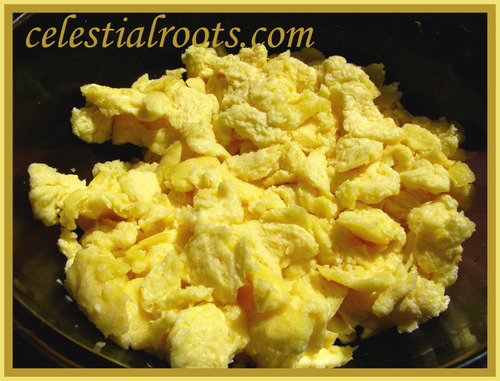
Fresh cheddar curds squeak on the teeth when bitten, have a rubbery texture, and a mild taste. When melted in the presence of other foods, they develop a unique, almost velvety consistency for a cheese, and so have the ability to lift everyday foods up to gourmet status. They are the defining ingredient of poutine, are great in tortillas or nachos, and may even be breaded and deep fried (if you deep fry them, try a little homemade cranberry sauce on the side). They are easy to make, I’ll give the recipe here for pasteurised milk, and for those lucky enough to have their own cow, the recipe for raw milk as well.
We will need a big double boiler – two slightly different sized stock pots are ideal. A stainless steel steamer basket, some stainless steel lids or a rack may be useful because the bottom of the inner pot needs to be clear of the water in the outer pot, otherwise the cheese may scald. We will need a thermometer, of the metal probe type preferably, and we will also need a knife, some cheesecloth and a colander.
Ingredients
Pasteurised milk Raw milk
4 litres (1 gal) milk 4 litres (1 gal) milk
Calcium chloride -
Culture C 201 or Cultured buttermilk
milk kefir whey
½ tsp rennet ½ tsp rennet
250 ml water 250 ml water
1-2 tsp salt 1-2 tsp salt
In using raw milk, the need to add calcium chloride is removed (its role is to repair the damage caused when milk is pasteurised). Whenever you see a cheese recipe that calls for calcium chloride, ignore this step if you are using raw milk. Likewise with the inoculation culture; a culture will either be mesophilic (likes medium temps), or thermophilic (likes warmer temps). Where a thermophilic culture is called for, use kefir milk or whey; and where a mesophilic culture is called for (as in Feta making), use cultured buttermilk. Because cheddar cheese cultures (eg C-201) are thermophilic, but the curd making procedure uses only moderately warm
temperatures, a little milk fat left in the buttermilk will produce a suitable
culture for raw milk if left in a covered jar on the bench for 3 days or so. Specific cultures are useful to imitate a desired cheese, but there is also nothing wrong with creating our own local version of these cheeses, using the organisms native to milk, kefir, and our local environment.
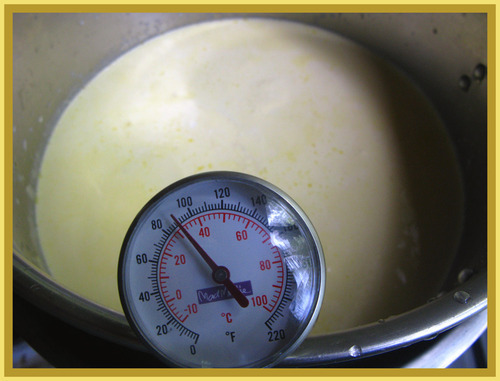
First step is to put the milk in the double boiler, and bring it up to 32° C (90° F). At this point, add the calcium chloride if using, annatto (optional colouring) if using, and your culture source. Maintain this heat for 30 minutes.
To colour the curds, annatto is often used (annatto is a plant extract that is harmless and serves only to colour), but the best way to get colour is to buy milk from pasture raised cows. Cheese and butter from pasture raised cows is yellow, and while vitamin K2 isn’t yellow, seeing naturally yellow dairy products indicates high levels because K2 is obtained by cows from fresh green grass. It is possible more and more these days to find milk at the store labelled “from pasture raised cows”, or even “pasture raised Jersey cows”. The protein (casein) from Jersey and Guernsey cows is more easily metabolised by the human body.
Step two is add the rennet. Rennet curdles the warmed milk, and lemon juice can often be used to the same end. We are using rennet here though, as it is a no fail method of curdling, and we are talking about 4 litres of prime milk! Lacto-vegetarians can purchase non-animal rennet, or the juice of half a lemon may be used. Stir the rennet into the room temperature cup of water and run over the back of a wooden spoon covering as much of the surface as possible. Stir for 30 seconds with the spoon, first pushing up and down over the entire surface to mix the rennet vertically, and then stir normally. Maintain the temperature for 30 minutes, then check for what cheese makers call a ‘clean break’. Run a knife along the edge of the pot. The milk should have separated into one coherent mass floating in a pool of whey. If the mass separates cleanly from the side of the pot, it is ready. If you make a cut with the knife and the mass separates, and fills with a clear liquid it is ready. If the liquid either between the mass and the pot or within the cut is cloudy, wait a few minutes more.
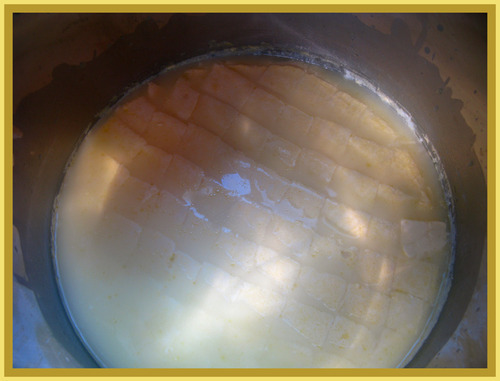
Once we have a clean break, slice the mass of milk solids into 2 cm (¾ inch) cubes. With 4 litres of milk, we will need to perform a series of cuts at a 45° angle to ensure a small size on the entire vertical plane (to the very bottom of the pot). Don’t worry about getting a whole pot full of perfect little 2 cm cubes, this is not going to happen. We just do the best we can, and our curds will break apart from these cubes as we stir. Which we will do now, for five minutes or so.
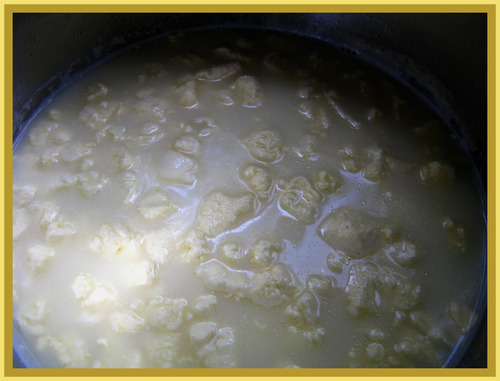
After cutting the curd and stirring to start the breaking apart process, step four involves a slow raising of the temperature to 40° C (104° F). Stir occasionally, and heat anywhere up to 90 minutes in this step. The longer the heating, the drier the curds will be. Lift the curds out on a spoon to see the progress, and we can call this step finished when they look the way we want them to.

Next step is to drain the curds. Place some cheesecloth inside a colander and pour the curds and whey into it. We are left with a mass of wet, uneven curds which we want to press for a few hours. Wrap the cheesecloth tightly around the curds, and fold the ends under. Place a bit of wood or a plate on top of the cloth-wrapped curds, then fill a big jar with water, and sit this on top. Once pressed, we are left with curds that are dry, just like those in the very first photo. Put the curds in a bowl, and sprinkle some salt over them Pour off any excess whey, then store in glass in the fridge.
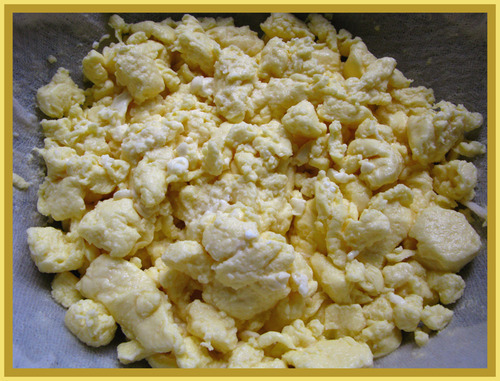
After that, use them any way you like, but do so within four days. These curds are at the height of their powers straight away, so plan a meal for the time they’ll be ready! We had free range organic chicken drumsticks, pan fried in butter, then cooked in a casserole with gelatine rich turkey stock. The pan juices were used to make a gravy – 1:1 butter/chicken fat:chick pea flour, with gelatine rich turkey stock added until the desired consistency. Green beans were fried lightly in butter, and organic Sebago potatoes were made into chips (aka French fries). The chips are put on the plate, the curds are broken up small and place on the hot chips, then the hot gravy is poured over. The dish of potato chips, fresh cheddar curds and gravy is called poutine, a speciality of Quebec, which is a place I love (but not just for the poutine).
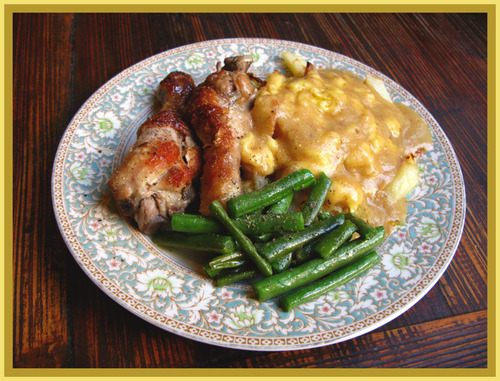
https://www.facebook.com/celestialroots
http://www.celestialroots.com/
Magic is the Intelligence of Love